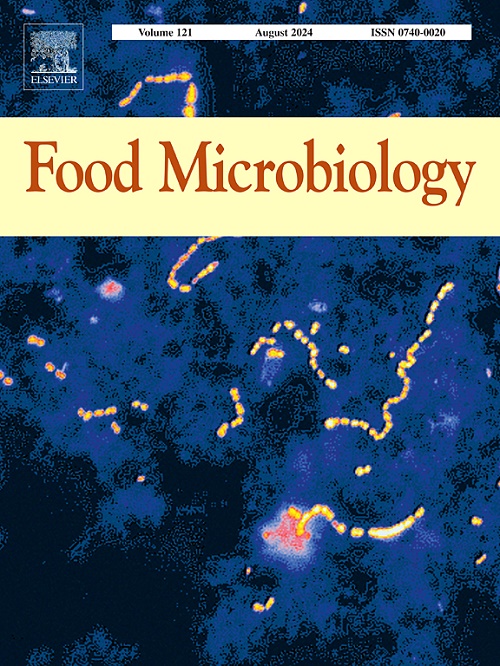从第三国进入欧洲联盟的航空旅客没收的食品:人畜共患病和多重耐药细菌的微生物学分析和基因组特征
IF 4.5
1区 农林科学
Q1 BIOTECHNOLOGY & APPLIED MICROBIOLOGY
引用次数: 0
摘要
从第三国非法进口到欧盟的动物源性食品是人畜共患病和多耐药性细菌病原体的潜在传播途径。在此,我们收集了在德国法兰克福国际机场(FRA)从非欧盟国家入境的旅客身上没收的非法进口食品。我们对总共 100 份食品样本进行了微生物检测,以确定是否存在食源性和多重耐药病原体,并测定了卫生参数。为此,对样品中的沙门氏菌属、单核细胞增生李斯特菌、金黄色葡萄球菌、产志贺毒素大肠杆菌(STEC)、耐甲氧西林金黄色葡萄球菌(MRSA)和广谱β-内酰胺酶(ESBL)/产AmpC肠杆菌进行了定性检测。微生物定量分析包括需氧中嗜酸菌落计数、单核细胞增多症、凝固酶阳性葡萄球菌、肠杆菌和大肠杆菌计数。总体而言,在 36% 和 23% 的样本中分别检测到了肠杆菌和大肠杆菌,这表明存在卫生缺陷,而在 17% 的样本中观察到了食源性病原体。对选定的分离物进行了全面的基因型分析,并对其进行了全基因组测序。结果表明,金黄色葡萄球菌分离物(n = 11)显示出多种多样的基因型特征,其中一个分离物属于新分配的序列类型 ST8323。三个金黄色葡萄球菌分离物被归类为多重耐药菌,其中包括一个 MRSA。肠炎沙门氏菌分离物(n = 3)分属三个血清型(乌干达、阿尔托纳、劳福),对所有测试的抗菌药物均敏感。此外,在获得的单核细胞增多性酵母菌分离物(n = 3;ST8、ST121、ST425)中未检测到抗药性。在 23 个假定的共生大肠杆菌分离物中,有 3 个观察到多重耐药性,而单个 STEC 分离物(O43:H2)则是易感的。此外,我们还获得了 5 个产 ESBL 的肠杆菌分离物,其中 1 个分离物携带罕见的 blaSHV-168 亚型。总之,这些数据表明,飞机乘客行李中的非法进口物品会促进人畜共患病和多重耐药细菌分离物的传播,包括那些对第三代头孢菌素和喹诺酮类药物耐药的分离物。这有助于新描述或不常见菌系的传播。本文章由计算机程序翻译,如有差异,请以英文原文为准。
Food products confiscated from air passengers travelling from third countries into the European Union: Microbiological analyses and genomic characterization of zoonotic and multiresistant bacteria
Illegal imports of food of animal origin from third countries into the EU are a potential transmission route for zoonotic and multiresistant bacterial pathogens. Here, we collected illegally imported food products that were confiscated from passengers arriving from non-EU countries at Frankfurt International Airport (FRA), Germany. A total of 100 food samples were microbiologically tested for the presence of foodborne and multiresistant pathogens and hygiene parameters were determined. For this, samples were qualitatively examined for Salmonella spp., Listeria monocytogenes, Staphylococcus aureus, Shiga toxin-producing Escherichia coli (STEC), methicillin-resistant S. aureus (MRSA), and extended-spectrum β-lactamase (ESBL)-/AmpC-producing Enterobacterales. Quantitative microbiological analyses included aerobic mesophilic colony counts, L. monocytogenes, coagulase-positive staphylococci, Enterobacterales and E. coli counts. Overall, Enterobacterales and E. coli were detected in 36 % and 23 % of the samples, respectively, indicating hygiene deficiencies, while foodborne pathogens were observed in 17 % of the samples. Selected isolates were subjected to a comprehensive genotypic analysis, for which they were whole genome sequenced. It was demonstrated that the S. aureus isolates (n = 11) revealed a wide variety of genotypic profiles, with one isolate belonging to a newly assigned sequence type ST8323. Three S. aureus isolates were classified as multiresistant, including one MRSA. The Salmonella enterica isolates (n = 3) belonged to three serovars (Uganda, Altona, Rauform) and were susceptible to all antimicrobial agents tested. Further, no resistance was detected in the obtained L. monocytogenes isolates (n = 3; ST8, ST121, ST425). In three of the 23 presumed commensal E. coli isolates multiresistance was observed, whereas the single STEC isolate (O43:H2) was susceptible. In addition, we obtained five ESBL-producing Enterobacterales isolates, of which one isolate carried a rarely described blaSHV-168 subtype. Overall, the data show that illegal imports in the baggage of airline passengers can facilitate the spread of zoonotic and multiresistant bacterial isolates, including those resistant to third-generation cephalosporins and quinolones. This contributes to the transmission of newly described or uncommon lineages.
求助全文
通过发布文献求助,成功后即可免费获取论文全文。
去求助
来源期刊

Food microbiology
工程技术-生物工程与应用微生物
CiteScore
11.30
自引率
3.80%
发文量
179
审稿时长
44 days
期刊介绍:
Food Microbiology publishes original research articles, short communications, review papers, letters, news items and book reviews dealing with all aspects of the microbiology of foods. The editors aim to publish manuscripts of the highest quality which are both relevant and applicable to the broad field covered by the journal. Studies must be novel, have a clear connection to food microbiology, and be of general interest to the international community of food microbiologists. The editors make every effort to ensure rapid and fair reviews, resulting in timely publication of accepted manuscripts.
 求助内容:
求助内容: 应助结果提醒方式:
应助结果提醒方式:


